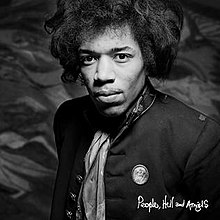People, Hell and Angels
| People, Hell and Angels | ||||
|---|---|---|---|---|
 |
||||
| Compilation album by Jimi Hendrix | ||||
| Released | March 5, 2013 | |||
| Recorded | March 1968 – August 1970 | |||
| Studio |
Record Plant Studios, Hit Factory, Sound Centre and Electric Lady Studios, New York City; Fame Studios, Muscle Shoals, Alabama |
|||
| Genre | Blues rock | |||
| Length | 52:33 | |||
| Label | Legacy | |||
| Producer | Jimi Hendrix, Eddie Kramer, Janie Hendrix, John McDermott | |||
| Jimi Hendrix chronology | ||||
|
||||
| Singles from People, Hell and Angels | ||||
|
||||
| Professional ratings | |
|---|---|
| Review scores | |
| Source | Rating |
| AllMusic | |
| American Songwriter | |
| Consequence of Sound | C– |
| The Guardian | |
| The Independent | |
| NME | 8/10 |
| PopMatters | 7/10 |
| Q | |
| Rolling Stone | |
| Slant Magazine | |
People, Hell and Angels is a posthumous compilation album by the American rock musician Jimi Hendrix. The fourth release under the Experience Hendrix deal with Legacy Recordings, it contains twelve previously unreleased recordings of tracks he was working on for the planned follow-up to Electric Ladyland. It was released on March 5, 2013.
The tracks featured on People, Hell and Angels are previously unreleased recordings of songs that Jimi Hendrix and fellow band members (mainly the Band of Gypsys lineup featuring Billy Cox and Buddy Miles) were working on as the follow-up to Electric Ladyland, tentatively titled First Rays of the New Rising Sun. The majority of the recordings are drawn from sessions in 1968 and 1969 at the Record Plant Studios in New York, with a few inclusions from Hendrix's brief residencies at Sound Centre, the Hit Factory, and his own Electric Lady Studios.
According to Eddie Kramer, the engineer who recorded most of Hendrix's music during his lifetime, this will be the last Hendrix album to feature unreleased studio material. Kramer said that several as-yet-unreleased live recordings would be available in the coming years.
People, Hell and Angels received generally positive reviews from critics. At Metacritic, which assigns a normalized rating out of 100 to reviews from mainstream publications, it received an average score of 74, based on 18 reviews. In Rolling Stone, David Fricke said Hendrix "plays at an elevated level in every setting" on the album, while The Wire called the recordings "among the best of Hendrix's late work". Patrick Humphries from BBC Music wrote that it "offers a tantalising glimpse of how Hendrix's genius might have progressed".AllMusic's Sean Westergaard was less enthusiastic and said the album "certainly isn't the place to start your Hendrix collection, but collectors will surely want to hear this". Writing for MSN Music, Robert Christgau called it a quality collection of leftovers highlighted by the songs "Somewhere" and "Let Me Move You", in which Hendrix comps behind saxophonist Lonnie Youngblood.
...
Wikipedia
